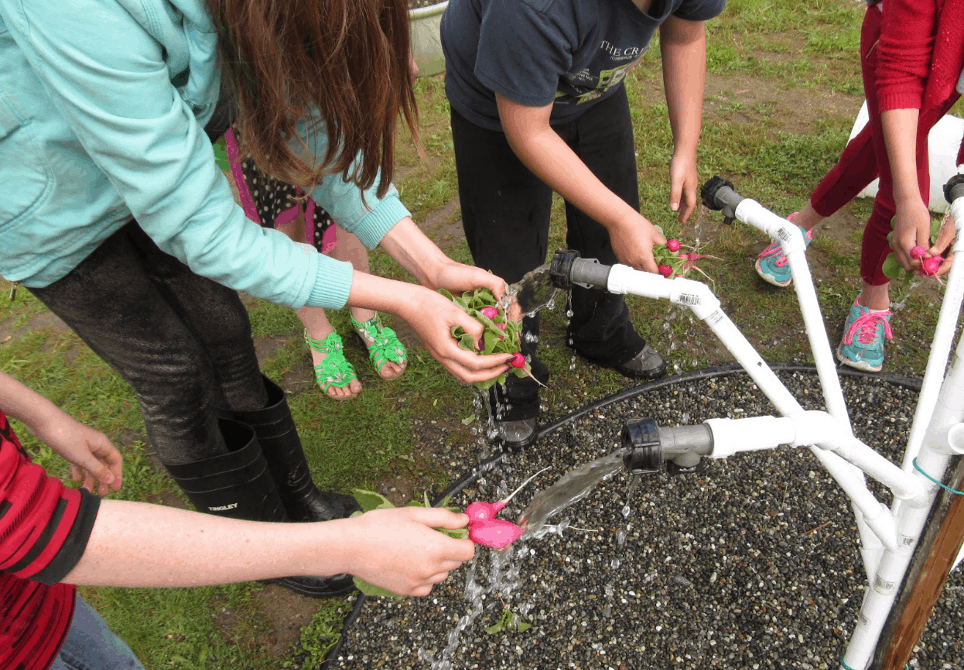Four Ways Students Learn from School Gardens

By Liz Wimmer
A few years ago, I volunteered in my son’s junior high lunch room.
I saw a lot of french fries with Cheese Whiz.
Thinking farther back to my own elementary school hot lunches, I can remember Salisbury steak and orange-flavored sherbet ice cream packaged in individual containers. (What is Salisbury steak anyway? A quick search and I found ground beef with gravy and mushrooms.) Vegetables? They might have served them. Let me think.
Imagine my surprise to find out that some students in the South Whidbey School District in Washington state are eating kale tacos. Voluntarily. Not only are they eating them, but they are growing the ingredients.
How did students make that leap, you wonder? Well, it turns out that kids eat more vegetables at school if they help grow them in the school garden.
In fact, school gardens are powerful places that deepen student learning. Here are four ways:
Values
“When taking care of a garden, kids can learn skills that build character,” said Margie Saidel, vice president of nutrition and sustainability at Chartwells K12, which manages food service for school districts across the country and provides support for district gardens.
What are some ways that working in a garden teaches values?
- Plants need regular water and weeding. Responsibility? Check.
- Plants grow over days or even a season. Patience? Check.
Nutrition
School gardens provide opportunities to build healthy eating habits. School districts that participated in Chartwells’ pilot garden program saw a 70 percent increase in students selecting fruits and vegetables in the cafeteria, Saidel said.
The fact that kids are involved in growing them makes a difference. “They’re excited that the vegetables come from their garden, and they or their classmates helped grow them,” said Saidel.

“Kids who are working in and eating produce from the school garden even influence their families’ eating habits,” said Cary Peterson, farm and garden coordinator for South Whidbey School District. “It is driving families to eat more vegetables—families are telling me this—and kids now want gardens at home.”
Hands-on Learning
Elementary and middle school students in South Whidbey also learn through a garden-based curriculum, Peterson said. “They can dig the beds, plant and participate in every part of harvesting the vegetables.”
Students learn about the seasons as they watch the cycle of the farm throughout the year. For instance, second-graders plant potatoes, and they harvest them as third-graders to use in their Thanksgiving celebration.
A variety of core subjects, like math, science and language are easy to integrate in a meaningful way into garden lessons. “If we’re studying decomposition, they are turning compost,” said Peterson.
Sustainability
As a company whose business is food, Chartwells notices that communities express interest in eating more locally grown food. When kids participate in the life of a garden, they see the full cycle of growing food, then cooking or preparing it to eat.
In the case of South Whidbey School District, students also watch vegetables go from the garden to the school cafeterias. The district took a big step when they recently became the first in the nation to negotiate safety protocols with Chartwells that allow them to deliver their produce to the school cafeterias.
“Even kids not in the garden are excited that their classmates are involved in growing their food,” said Saidel.
You Can Too
Wondering how your students can grow a garden?
Peterson shared that, while a larger garden can have so much impact—students can work in the South Whidbey garden and eat produce there–it’s best to start small with whatever size of garden the school community can initially support.
The South Whidbey School District followed students’ interests and kept expanding and growing their gardens over a number of years. They received community and business support, and now the district runs its garden on an old sports field in addition to some smaller plots at the schools.
Chartwells’ support for school gardens is growing too. The company is helping other districts start or expand their garden programs. They now offer a Garden 1, 2, 3 Quick Start Guide and webinars to teach effective ways to grow organic gardens. For more detailed information on school gardens, you can order the eat. learn. live. School Garden Program developed by Chartwells in partnership with KidsGardening.org.
Wondering about whether you have the right space or climate?
“You can grow vegetables in many different climates and spaces,” says Saidel. She described non-traditional garden spaces such as towers or containers that schools can use. Typically gardens use soil, but others are hydroponic and use fertilizer-amended water. All you need is “water and a light source.”
In South Whidbey in mid-September, Peterson described delivering 150 pounds of food to the school cafeterias and preparing for 500 students to visit the garden. “It’s going to be fun to see all those vegetables get picked and disappear into children,” she said. “Someone said we should weigh the children before and after leaving the farm!”
This blog is part of our “Place-Based Education” blog series. To learn more and contribute a guest post for the series, check out the PBE campaign page. Join in the conversation on social media using #PlaceBasedEd. For more on Place-Based Education see:
- Five Tips for Testing the Place-Based Education Waters
- Parenting, Learning & The Power of Place
- Expanding & Enriching Relationships in Place-Based Education
- Genius Loci: Place-Based Education & Why It Matters
Liz Wimmer is a writer and content specialist at the University of Washington. Follow her on Twitter: @LizWimmer
Stay in-the-know with all things EdTech and innovations in learning by signing up to receive the weekly Smart Update.





0 Comments
Leave a Comment
Your email address will not be published. All fields are required.